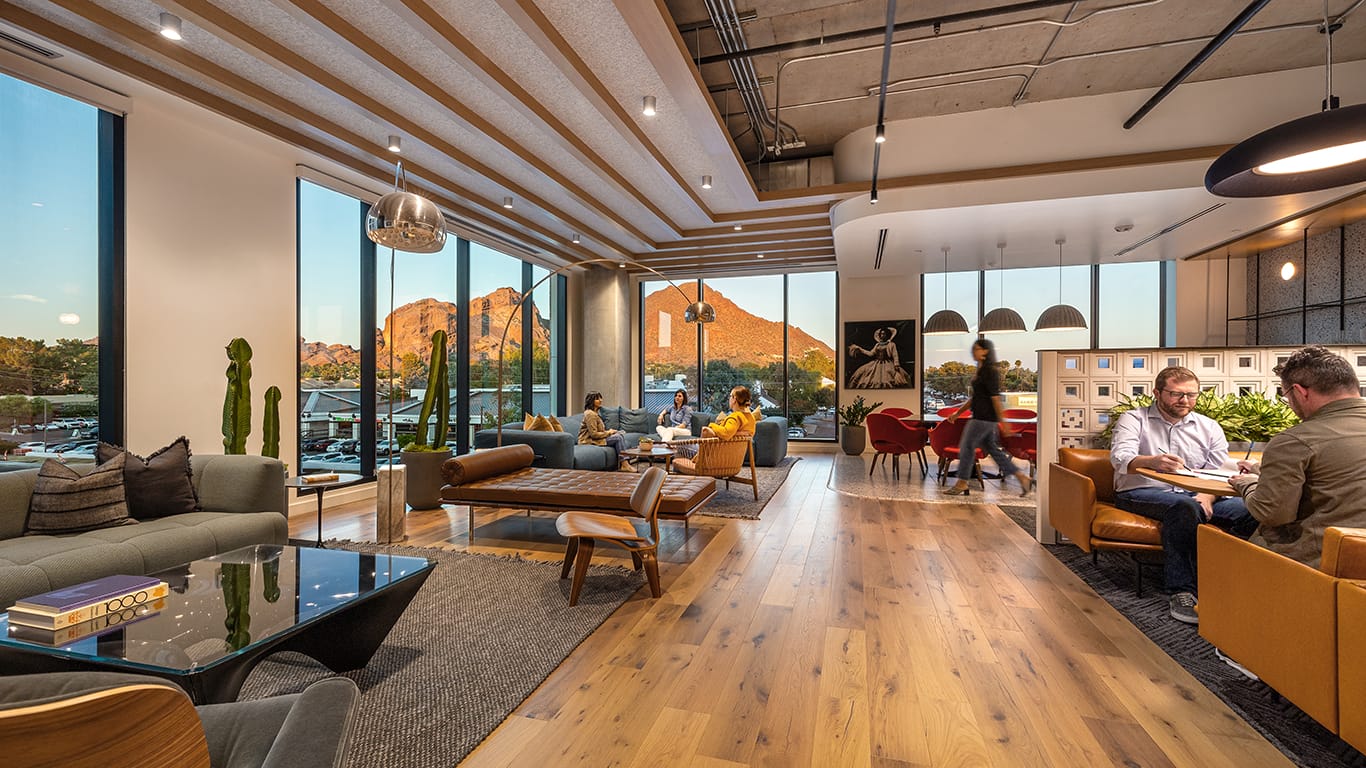If you think more and more employers have embraced the full-remote work model, you are not alone, but recent statistics may just challenge that thought. According to a recent Forbes article, 90% of companies will return to the office by 2024. Compared to a 27% return to the office in 2023, this is not only a significant return rate but it also reveals the workscape we currently find ourselves. Members of AZCREW have shared insight into what it takes to make the most out of modern office space and work schedules.
MORE NEWS: Ranking Arizona: Top 10 interior design firms for 2024
Whether they are looking for space in Phoenix or offices to let in Fourways, employers seem to largely want their employees in the office — some embracing full-time work models and other hybrid work schedules. But at the same time, these businesses are evaluating the spaces they occupy. Do they need the same footprint they once occupied? Is it time to downscale? Yet, it isn’t even simply the amount of space they’re evaluating, but also the quality and design too.
For those immersed in the commercial real estate side of Phoenix Metro workspaces, the climate can be described as dynamic, if not even a bit shifty. According to Avison Young’s fourth-quarter 2023 Phoenix Office Market Report, “The Phoenix office market continues to see persistently high vacancy, with total vacancy sitting at 24.5% for Q4 2023.”
So, what is a company, developer, property manager, or tenant to do in this office market?
One major piece of advice local experts offer: Don’t compare one company’s space requirements to another; consider the specific needs of each particular work environment.
“Everyone works differently,” says Lindsey Carlson, senior vice president for Colliers Arizona. “It’s not one-size-fits-all [for office space]. Leaders need to do what works best for their company and employees versus following another company in a different industry.”
Carlson elaborates by offering this example: “I often hear people comparing what Fortune 100 companies are doing with what they are doing as a regional or local company that operates very differently than those companies,” she says. “Understanding the needs of a tenant upfront is a crucial step to achieving success.”
Flexibility is No. 1
One thing, for which all our interviewed experts agree is a present-day workspace requirement: flexibility.
“Flexibility is something that people enjoy and they like the autonomy of having that,” says Karen Jarvis, operating principal for DORIS Research. “And that looks different for every organization.”
Being nimble is essential — and intertwined — with both work schedules and physical space.
“We have worked with a company that has some employees that have to be in the office five days a week. And their other employees have to be in the office four days a week, and then one day is your flex day,” Jarvis explains.
Adds Michelle Heeb, president and CEO of Forward Tilt: “I think [physical] flexibility translates to creative spaces to engage in free-flow conversation, connecting the brand with the interiors.”
Magic space
For companies seeking to marry varying schedules with the magic physical office formula, it can get tricky. While many of the physical aspects desired by businesses remain the same as what they were pre-COVID — collaborative spaces and technology-enabled places — the way in which they are structured today is different.
While “hot-desk seating,” with vast rows of bench-like tables and open seating reigned supreme in collaborative work environments of the past, employees and employers alike are craving more intimate collaborative areas. In fact, a Wall Street Journal story used the word “hate” in conjunction with modern, post-COVID employees’ reactions to hot-desk seating. Many expressed feeling increased pressure to perform, lopsided favoritism from leadership and endless opportunities for distraction.
“People want the opportunity to flex their space,” Heeb says. “We’re seeing more neighborhoods and smaller groupings versus a big sea of workstations. Even if there are 200 people on a floor plate, you want to feel like there are only 20 in your group.”
To accomplish both flexible and smaller spaces, Heeb says that mobile dividers and partitions have become more popular.
“We are doing more and more with movable and demountable walls,” Heeb continues, “because you might want offices and conference spaces in the middle of a floor plate and maybe you want that changed in a year.”
Adds Carlson, “Leaders that allow teams to personalize and customize their own space/department within the larger space but still have it be cohesive with the rest of the office is the ideal scenario to energize both the space and its employees.”
Another important aspect of the 2024 (and beyond) workspace noted by Jarvis is connectivity. “That’s what we look at when people are working together, but there is no business objective,” she explains, “and that’s where culture building comes in. One of the biggest misconceptions that we’re hearing frequently is, ‘Hey, let’s collaborate. Everybody needs to come in and we’re going to collaborate,’ when a lot of times leaders mean ‘let’s connect.’”
Amenities
There’s a reason why developments and redevelopments such as The Grove, Bond, South Pier and Novus Innovation Corridor are making waves as premier office space locations. These mixed-use marvels contain another sought-after attribute for employers/employees alike: amenities.
“Mixed-use spaces and developments will become more and more prevalent,” Carlson notes. “No longer are you going to have a standalone office building where you just go to work. Now and in the future it will have residential, retail/restaurants, office and coworking all in one.”
Jarvis agrees with Carlson, adding that amenities will likely become increasingly more valuable, no matter the size or shape of the workspace. “Maybe [a business] has a smaller footprint, maybe not, but they’re willing to spend more for some of these amenities because they know it’s important to their employees,” she says.
Heeb adds important insight regarding workplace amenities, in that not all amenities require a fixed/permanent spot — i.e. an onsite pickleball court, rooftop, speakeasy or cafe. “[Employees} want to go into a space that feels more like a hotel, especially when it comes to redevelopments,” she says. “That can even translate to Tuesday night cocktail hour, food trucks on Wednesday, or a coffee bar on Thursday. They want activities, excitement and community.”
Energizing spaces
In July 2023, Forbes referenced a survey by FlexJobs reporting that “96% of workers believe a remote or hybrid work arrangement would be best for their mental health.” While hybrid does seem to satisfy the best of both remote and in-office worlds, there are a few “space dilemmas” that have been identified to simultaneously address both work models.
For example, in scenarios where only a handful of employees are in the office at any given time, office space can feel almost too open, creating a sense of overwhelm for some employees and a lack of motivation for others.
A flex schedule, although seemingly preferred, has forced businesses to evaluate what energizes their workspaces — or alternately what de-energizes them.
“What energizes me might be different than what energizes you,” Jarvis says. “My first initial response to ‘what energizes people?’ is if people aren’t in a space, what energy is there?”
Jarvis elaborates that “if you want people to be in the space, you have to support them in coming to the space and reduce any barriers to help make seamless transitions from the office to the home.”
Carlson echoes Jarvis’ scenario, sharing, “One complaint I hear about in having to go into the office is that it takes [employees] a long time to get set up at the office and to actually start work. If employers can make the technology/infrastructure work seamlessly and have a workspace set up to that employee’s needs, it removes much of the burden, frustration and inefficiencies of coming to the office.”
Bottom line, when it comes to energizing space, it’s important to curate environments specific to the needs of each particular company. To do so, Heeb brings us back to the No. 1 trend we’re seeing in modern workplaces: flexibility. “Every building, every space has a persona, and every company has a culture and a persona that might not be what they [fully want] today, but everybody has goals for what they want to be tomorrow,” she says. “I think we’ll see more cozy spaces and environments that allow you to work with smaller groups and be connected, but also still be part of the greater whole.”




